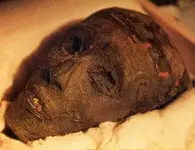rmptr
Silver Member
- Joined
- Dec 25, 2007
- Messages
- 3,274
- Reaction score
- 25
- Golden Thread
- 0
- Location
- Tierra del Fuego
- Detector(s) used
- Tesoro.Fisher.Garrett
- #1
Thread Owner
King Tut's Alien Necklace
This gypsy kryptonite is an alien life form, I just know it!
Can't seem to break the chain to my computer...
or is it the curse of caldwell ?
?

Tutankamen's tomb robbed in modern times?
According to a story about a documentary sponsored by the Earl of Carnarvon, King Tut's tomb was plundered during World War II.
So what of the broken ribs and the pharaoh's member, which were both intact when Howard Carter first opened the tomb, but have mysteriously disappeared?
So valuable was the tomb that it has been guarded round the clock since its discovery. However, there was one period when a modern grave robbery might have taken place. During the Second World War when the Egyptian desert was reduced to a battleground.
The latest tests indicate quite clearly that someone must have used this opportunity to deliberately cut away the pharaoh's ribs in order to get to the jewelled collar he was wearing and which was glued fast to the body by the ancient embalmer's sticky black resin. The extraordinary story of Tutankhamun is not over yet.
Who Stole King Tut's Jewels?
The missing benis showed up when Dr. Hawass conducted the CAT scans on Tut's mummy, within the plain wooden box under his body that Carter left King Tut in.
Now the question is: What happened to that necklace? What happened to the cut-away ribs?
The gallery of Harry Burton's King Tutankhamen photos at the Griffith Institute does not reveal which necklace was left on his body. Though photo P2002 looks promising. Maybe it was a vulture necklace, or? The link takes you to the page that shows Tut's mummy covered in a shroud (P2001), and uncovered (P2003) still with all the splendid jewels and mask, his golden hands and sceptres. But P2000 and P2002 might shock you.
Carter's notes on the mummy of Tut, and what was left on his head
On removing these last two objects it was found that the head wrappings were tied at the back in the manner of a chinon. Note linen headdress. (4S) Beneath more wrappings, a thin sheet gold band exactly similar to (4P) and in similar position was tied beneath the occiput by means of linen tape fastened by knot in centre - (see photo).
Upon the head was placed a sort of skull cap of fine linen and worked upon a design of curve serpent pattern, this was supposed to secure for the dead one a sight of the sun. (4T) This actual skull-cap of the thinnest cambric fabric having device of four uraeii worked with very fine faience and gold beads, the centres of the head of the cobras bearing small cartouches, takes in order sequence the letter 4T, and fits closely to the crown of the head. As it would have been practically impossible to remove this device owing to its fragile nature & minuteness of work, it was consolidated with paraffin wax and left in place.
The beaded skull cap seems to now be missing also. Did Dr. Hawass have them removed? It would have taken many hours of work since the linen cap the beads had been sewn on was too fragile to remove.
In the photo above from the King Tut exhibition website, the skull cap and gold band seem to be still in place.
But they also seem to be missing in the recent photos of King Tut's head when they put his body on display in the Valley of the Kings tomb.
Credit to Rene O'Deay
rmptr
This gypsy kryptonite is an alien life form, I just know it!
Can't seem to break the chain to my computer...
or is it the curse of caldwell
 ?
?
Tutankamen's tomb robbed in modern times?
According to a story about a documentary sponsored by the Earl of Carnarvon, King Tut's tomb was plundered during World War II.
So what of the broken ribs and the pharaoh's member, which were both intact when Howard Carter first opened the tomb, but have mysteriously disappeared?
So valuable was the tomb that it has been guarded round the clock since its discovery. However, there was one period when a modern grave robbery might have taken place. During the Second World War when the Egyptian desert was reduced to a battleground.
The latest tests indicate quite clearly that someone must have used this opportunity to deliberately cut away the pharaoh's ribs in order to get to the jewelled collar he was wearing and which was glued fast to the body by the ancient embalmer's sticky black resin. The extraordinary story of Tutankhamun is not over yet.
Who Stole King Tut's Jewels?
The missing benis showed up when Dr. Hawass conducted the CAT scans on Tut's mummy, within the plain wooden box under his body that Carter left King Tut in.
Now the question is: What happened to that necklace? What happened to the cut-away ribs?
The gallery of Harry Burton's King Tutankhamen photos at the Griffith Institute does not reveal which necklace was left on his body. Though photo P2002 looks promising. Maybe it was a vulture necklace, or? The link takes you to the page that shows Tut's mummy covered in a shroud (P2001), and uncovered (P2003) still with all the splendid jewels and mask, his golden hands and sceptres. But P2000 and P2002 might shock you.
Carter's notes on the mummy of Tut, and what was left on his head
On removing these last two objects it was found that the head wrappings were tied at the back in the manner of a chinon. Note linen headdress. (4S) Beneath more wrappings, a thin sheet gold band exactly similar to (4P) and in similar position was tied beneath the occiput by means of linen tape fastened by knot in centre - (see photo).
Upon the head was placed a sort of skull cap of fine linen and worked upon a design of curve serpent pattern, this was supposed to secure for the dead one a sight of the sun. (4T) This actual skull-cap of the thinnest cambric fabric having device of four uraeii worked with very fine faience and gold beads, the centres of the head of the cobras bearing small cartouches, takes in order sequence the letter 4T, and fits closely to the crown of the head. As it would have been practically impossible to remove this device owing to its fragile nature & minuteness of work, it was consolidated with paraffin wax and left in place.
The beaded skull cap seems to now be missing also. Did Dr. Hawass have them removed? It would have taken many hours of work since the linen cap the beads had been sewn on was too fragile to remove.
In the photo above from the King Tut exhibition website, the skull cap and gold band seem to be still in place.
But they also seem to be missing in the recent photos of King Tut's head when they put his body on display in the Valley of the Kings tomb.
Credit to Rene O'Deay
rmptr



